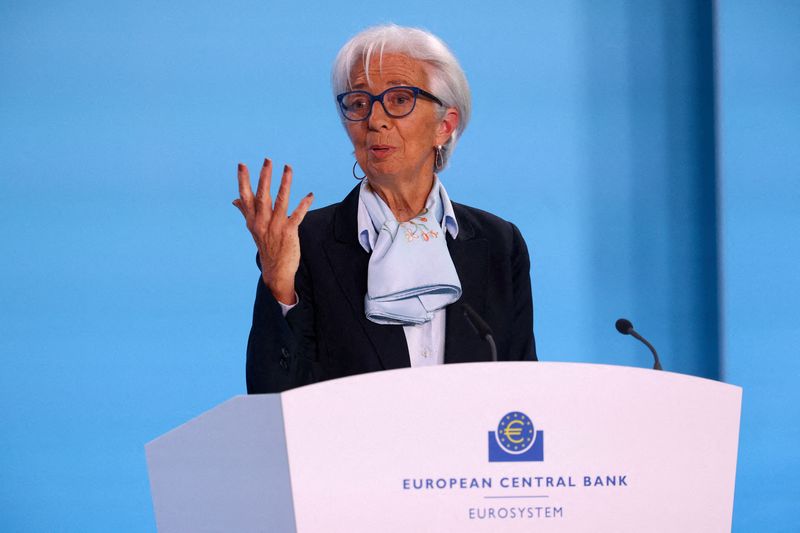By Francesco Canepa and Balazs Koranyi
FRANKFURT (Reuters) -The European Central Bank is all but certain to cut interest rates from record highs on Thursday and acknowledge it has made progress in its battle against high inflation, while also stressing the fight is not yet over given sticky services prices.
ECB policymakers have clearly telegraphed their intention to lower borrowing costs after seeing inflation in the 20 countries that share the euro fall from more than 10% in late 2022 to just above their 2% target in recent months.
The broad-based decline was seen as more than enough for the ECB to begin undoing the steepest streak of interest rate hikes in its history, which were a response to spiralling prices in the wake of Russia’s invasion of Ukraine.
Now, the ECB will join the central banks of Canada, Sweden and Switzerland in cutting rates and moving well ahead of the influential U.S. Federal Reserve.
But what had looked like the start of a major easing cycle only a few weeks ago now appears more uncertain amid signs that inflation may prove stickier than expected in the euro area, as has been the case in the United States.
This means that ECB President Christine Lagarde and her colleagues are unlikely to commit to a further rate reduction at their July meeting or beyond just yet.
Instead, they are expected to stress any further move would depend on incoming data and that borrowing costs need to remain high enough to keep a lid on inflation.
“Further cuts in September and December remain our central case,” HSBC economist Fabio Balboni said in a note. “But if the recent resilience in services inflation proves sustained, we see increasing chances that the ECB might have to be more cautious on the way down.”
All 82 economists polled by Reuters expected the ECB to trim its deposit rate to 3.75% on Thursday from a record 4.0%, in what would be its first cut since 2019.
But not all think it is a good idea.
Gabriele Foà, a portfolio manager at Algebris Investments, said the cut “may soon be viewed as a policy mistake” and JPMorgan economist Greg Fuzesi said it was “oddly rushed”.
“If economic data did not support a rate cut back in March, they do even less today,” Lorenzo Codogno at LC Macro Advisors said. “Inflation has not declined as the ECB had expected, indices more linked to domestic demand have increased, wage growth has risen, and overall demand and GDP growth have strengthened.”
NO DECLARATION OF VICTORY
ECB chief economist Philip Lane set the tone last week, saying that a rate cut would be no “declaration of victory” and the pace of further reductions would depend on progress on domestic inflation and demand.
Most economists still expected two further rate cuts by the end of the year, but markets only price one to two more moves, a big change compared to the start of the year when over five rate cuts were seen in 2024.
But some stronger-than-expected data over the last few weeks fuelled fears of a more difficult “last mile” on the way to 2% inflation than the ECB has been predicting — a concern often expressed by influential board member Isabel Schnabel.
Euro zone inflation rose more than predicted in May, with price growth in the services sector, which some policymakers singled out as especially relevant because they reflect domestic demand, rebounding to 4.1% from 3.7%, according to preliminary estimates.
This was likely to mirror larger-than-expected increases in wages in the first quarter of the year, which boosted consumers’ battered disposable income after years of below-inflation pay hikes.
But the real elephant in the room may be the Fed, which has clearly signalled a delay to its own easing cycle, fuelling some caution in Frankfurt as well.
“The pace of rate cuts will be dependent on the U.S. and the Fed,” Mohit Kumar, an economist at Jefferies said. “In the event that the Fed doesn’t cut rates at all this year – not our base case – we could see only two cuts from the ECB this year.”
A rebound in growth also reduced the urgency for the ECB, and the bank will likely raise some growth forecasts on Thursday, negating the argument that high rates are choking economic activity.

Still, new forecasts will continue to suggest inflation returning to the ECB’s 2% goal next year, keeping the central bank on course for more easing barring new inflation surprises.
“If anything, the five quarters of stagnation in the euro zone economy from autumn 2022 to the end of 2023 suggest that the ECB may have overreacted with its rate hikes,” Holger Schmieding, an economist at Berenberg, said. “Seen from this angle, somewhat lower rates make sense.”
>>> Read full article>>>
Copyright for syndicated content belongs to the linked Source : Investing.com – https://www.investing.com/news/economy-news/ecb-to-begin-cutting-rates-even-as-inflation-fight-continues-3472736































